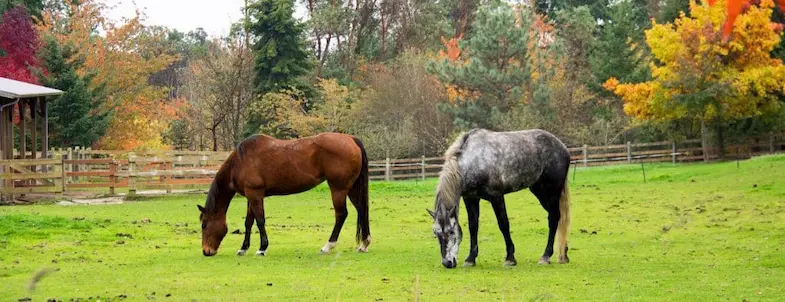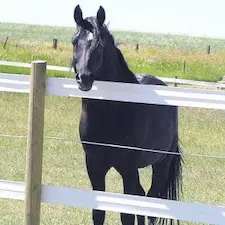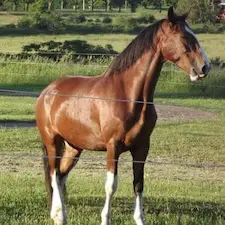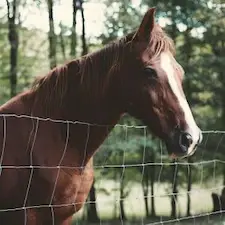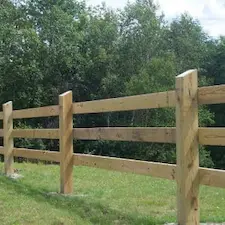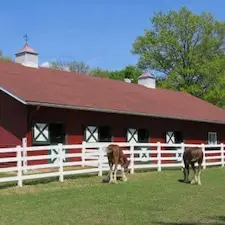Keeping a horse in your backyard (or your front yard for that matter) may seem like an easier option to that of keeping it at a livery yard but if you’re thinking about doing this then there’s a lot of things that you need to consider, not least the cost and time you’ll need to dedicate to looking after your horse (or horses).
Do you have enough land to keep a horse at home?
One of the most important things, and certainly the first thing, you need to think about is whether you have enough land to keep a horse or multiple horses or not. It’s not just grazing pasture that you need to consider, even if you’re not going to stable your horse you still need to prove some sort of shelter so that he can seek refugee from the elements if necessary. You also need to take exercise into consideration, if you don’t have enough space to exercise a horse then is there a place close by where you can take him for regular exercise.
How much land does a horse need?
To some extent the size of the horse will make a difference to the amount of grazing land they need but as a general rule of thumb one horse needs between 1 1/2 to 2 acres of pasture and, with every additional horse, you need to add another acre. This means that if you have three horses then you’ll need at least 4 1/2 to 5 acres.
While there’s no upper limit to the amount of pasture a horse has if you do have a lot you might want to consider sectioning it off into smaller paddocks. This will not only make it easier to maintain but will also help you to manage worms and keep them a minimum.
Does my horse need a shelter?
Even in the wild horses need shelter when the weather gets too hot or when it’s raining or windy. There are different types of shelter and its entirely up to you what sort of shelter you opt for. If you’re not able to make use of any natural shelter you might have then it’s important to build a shelter in the right place. If possible it should be at the top of any slope to reduce the risk of it becoming overwhelmed with water. It also should either be right against the boundary or far enough away from it so that no horses can get stuck between the two. An ideal place for a shelter is with the back against the prevailing wind so that it provides shelter from the wind, snow and any other winter nasties, but also in a shaded area if possible. This will help to keep your horse cooler during the summer heat.
How much space do I need to exercise my horse?
There are no fixed rules on how much space a horse needs to be exercised and to some extent, it does depend on the sort of exercising you’re doing. For example, if you’re lunging your horse or just schooling him then you don’t need much space, around 50ft (15 meters) is enough for him to be able to trot. If however, you and your horse are preparing for a show jumping competition then you’ll need to at least 164ft (50 meters) by 262ft (80 meters), although this is the minimum.
If you just want to ride for pleasure and aren’t worried about lunging or any sort of competition and have areas around where you live that you can legally ride then there’s no reason why you would need to have space at home for exercise.
How much does it cost to keep a horse at home?
The next thing to consider is how much will it cost to keep a horse at home and is it really going to be cheaper than keeping him at a boarding yard. It might seem like keeping your horse at a yard is expensive but, depending on the type of board you go for, there are a lot of extras included such as hay, bedding and feed. Some stables will also have an agreement with the farrier and or equine dentist where they treat a number of horses at the same time to keep the cost per horse/owner down. If you want to keep your horse at home then you’ll need to consider all of these costs.
It can vary drastically from state to state and country to country but the tables below should help to give you an idea of monthly boarding costs.
|
| USA | Canada | UK | Australia |
| Pasture / Grass | $111 – $188 | $138 – $249 | £86 – £155 | $155 – $276 |
| Self-Board/ DIY | $267 – $421 | $242 – $545 | £151 – £347 | $269 – $619 |
| Full Board | $365 – $972 | $482 – $1,285 | £300 – £800 | $536 – $1,428 |
Unless you’re horse is kept at full board you’ll also need to factor in the costs of feed, bedding, hay etc.
|
| USA | Canada | UK | Australia |
| Feed | $120 – $305 | $160 – $400 | £100 – £250 | $180 – $445 |
| Hay | $115 – $230 | $150 – $308 | £95 – £190 | $170 – $340 |
| Bedding | $160 – $510 | $110 – $675 | £130 – £420 | $230 – $750 |
| Water | $20 – $34 | $60 – $97 | £26 – £37 | $29 – $47 |
| Supplements | $70 – $130 | $93 – $174 | £54 – £101 | $107 – $199 |
| Treats | $10 – $20 | $13 – $36 | £7 – £15 | $15 – $30 |
The table below gives you an idea of other fees and bills that you’ll need to pay, most of them aren’t monthly costs so I’ve given the yearly cost then an approximate monthly cost. I included insurance in the table because if your household policy doesn’t cover keeping a horse at home you’ll need to take out a separate policy. I’ve also added a miscellaneous category for things that you hadn’t expected, things like repairing fencing, new rugs, etc.
|
| USA | Canada | UK | Australia |
| Vet fees | $60 – $180 | $80 – $240 | £50 – £150 | $90 – $270 |
| Insurance | $60 – $300 | $80 – $396 | £50 – £250 | $90 – $440 |
| Farrier | $270 – $970 | $350 – $1,285 | £220 – £800 | $390 – $1,430 |
| Dentist | $60 – $120 | $80 – $160 | £50 – £100 | $90 – $180 |
| Worming | $50 – $135 | $65 – $175 | £40 – £110 | $70 – $195 |
| Miscellaneous | $1,000 | $1,000 | £1,000 | $1,000 |
| Approximate month total | $125 – $225 | $138 – $271 | £118 – £201 | $144 – $260 |
Once you’ve taken the financial costs into consideration it’s important to also think about the cost on your time. If you keep a horse at home then it’ll be your responsibility to feed, groom, muck out, exercise, and generally care for your horse. Not everybody can spare the time to do this but its definitely something you need to consider.
Preparing your property for keeping a horse at home
You’ve worked everything out and you know that not only do you have the space but you also have the time and money to keep your horse at home, the next step is to prepare your home. You might be lucky and already have all of the amenities but most of us won’t so you’ll need to think things fencing, water supply, waste storage, and security.
Fencing for keeping a horse at home
You need to have secure fencing to keep your horse safely in his pasture but there’s a lot of different types of fencing to choose from. There may also be local laws in place for the type of fencing you’re allowed near public areas as well as what, if any, signage you need, for example, if you have an electric fence along a public road then you may be required to place signs alerting the public to the fact the fence is electric.
Most fencing is made by securing fence posts into the ground and then attaching any number of different materials to the posts, each one of them having their advantages and disadvantages.
Electric
As you would imagine electric fences can give a mild electric shock if you touch or lean on them, although with some fences the degree of the shock can be altered. Generally, electric fences are made from coated wire but can be difficult for the horse to see, especially from a distance, which can make them more likely to get caught up in the fence. While electric fences can prove a good deterrent too would be thieves they can be expensive fencing, especially when you take into account they’ll need some sort of power too, whether from mains power or a vehicle battery. There are a few types of electric fencing:
- Wire – While being the cheapest form of electric fencing this is the hardest type for horses to see.
- Tape – This is available in a variety of different widths making it easier for the horse to see.
- Braids – Coated metal conductors are braided together to create a fence that is available in a variety of colors and disturbs the power most effectively, although it does cost the most to run.
- Conductive Polymer – This is probably the safest form of electric fencing because it consists of the wire being covered in a conductive polymer casing, making it far more visual to horses. That said though it does also take the most amount of time to install.
Plain Wire
Wire fencing is the cheapest form of fencing around and is simply a length of wire that is fixed to fencing posts are regular intervals. Most fences will have a number of lines of wire but the problem can be that, like electric fencing, it can be difficult for the horse to see which can prove a dangerous hazard. You can get wire coated in a colored polymer which makes it easier for a horse to see but does also push the cost up.
Mesh
This is one of the most popular types of fencing and is available in a pre-made form that can simply be unwound and fixed to fence posts making it quick and easy to install. The mesh is regularly spaced with either diamond or rectangular gaps that are no bigger than 2-4 inches, this greatly reduces the risk of a horse getting caught up in the fencing. Mesh fencing is also much easier for the horse to see.
Wood Rail
By far the most popular type of fencing, it’s made by fixing wooden rails between the fence posts. The rails not only give it a rustic look but make it extremely visible to horses, which makes it practically impossible for them to get tangled up in the fencing. The problem with this fencing tough is that although it’s relatively easy to install it does need to be maintained and rails will need to be replaced from time to time. It’s also by far the most expensive type of fencing.
Vinyl Rail
Vinyl fencing looks like wooden fencing from a distance but doesn’t need much in the way of maintenance. The disadvantage for vinyl though is that it’s, when compared to wood, it can be much harder to repair if a rail breaks.
Barbed Wire
This should never be used as the main fence for horses but can be used as an additional outer fence.
Below is a table giving you an idea of how much different fencing options might cost, I’ve included the cost per foot as well as the cost to completely fence a square acre.
|
| USA | Canada | UK | Australia |
| Wire (electric) | Foot: $0.10 – $0.15 Acre: $83.60 – $125.40 | Foot: $0.13 – $0.20 Acre: $108.68 – $167.20 | Foot: £0.07 – £0.12 Acre: £58.52 – £100.32 | Foot: $0.15 – $0.23 Acre: $125.40 – $192.28 |
| Tape (electric) | Foot: $0.04 – $0.28 Acre: $33.44 – $234.08 | Foot: $0.05 – $0.37 Acre: $41.80 – $309.32 | Foot: £0.03 – £0.22 Acre: £25.08 – £183.92 | Foot: $0.06 – $0.43 Acre: $50.16 – $359.48 |
| Braids (electric) | Foot: $0.10 – $0.14 Acre: $83.60 – $117.04 | Foot: $0.13 – $0.19 Acre: $108.68 – $158.84 | Foot: £0.07 – £0.11 Acre: £58.52 – £91.96 | Foot: $0.15 – $0.21 Acre: $125.40 – $175.56 |
| Conductive Polymer (electric) | Foot: $0.50 – $1.00 Acre: $418 – $836 | Foot: $0.67 – $1.33 Acre: $560.12 – $1,115.87 | Foot: £0.39 – £0.78 Acre: £326.04 – £652.08 | Foot: $0.77 – $1.53 Acre: $642.72 – $1,279.08 |
| Plain Wire | Foot: $0.03 – $0.12 Acre: $25.08 – $100.32 | Foot: $0.04 – $0.16 Acre: $33.44 – $133.76 | Foot: £0.02 – £0.09 Acre: £16.72 – £75.24 | Foot: $0.04 – $0.18 Acre: $33.44 – $150.48 |
| Polymer Wire (per line) | Foot: $0.14 – $0.21 Acre: $83.60 -$175.56 | Foot: $0.19 – $0.28 Acre: $158.84 – $234.08 | Foot: £0.11 – £0.16 Acre: £91.96 – £133.76 | Foot: $0.21 – $0.32 Acre: $175.56 – $267.52 |
| Mesh | Foot: $1.39 – $1.89 Acre: $1,162.04 – 1,580.04 | Foot: $1.85 – $2.52 Acre: $1,546.60 – $2,106.72 | Foot: £1.09 – £1.48 Acre: £911.24 – £1,237.28 | Foot: $2.13 – $2.89 Acre: $1,780.68 – $2,416.04 |
| Wooden Rail | Foot: $3.00 – $9.00 Acre: $2,508 – $7,524 | Foot: $4.00 – $12.01 Acre: $3,344 – $10,040.36 | Foot: £2.35 – £7.05 Acre: £1,964.60 – £5,893.80 | Foot: $4.59 – £13.78 Acre: $3,837.24 – $11,520.08 |
| Vinyl Rail | Foot: $0.90 – $1.60 Acre: $752.40 – $1,337.60 | Foot: $1.20 – $2.14 Acre: $1,003.20 | Foot: £0.70 – £1.25 Acre: £585.20 – £1,045 | Foot: $1.38 – $2.45 Acre: $1,153.68 – $2,048.20 |
| Barber Wire | Foot: $0.03 – $0.05 Acre: $25.08 – $41.80 | Foot: $0.04 – $0.06 Acre: $33.44 – $50.16 | Foot: £0.02 – £0.03 Acre: £16.72 – £25.08 | Foot: $0.04 – $0.07 Acre: $33.44 – $58.52 |
| Unless stated all costs are per section | ||||
How to install fencing for your horse at home
Due to how important it is that the fence is installed properly and is secure a lot of people opt to have it professionally installed. If you don’t want to do this the make sure that you take the following into account:
- The area is big enough for your horse’s needs. If you’re planning to increase the number of horses you keep in the future make sure you factor this in when installing the fence.
- As a rule, the fence posts should be spaced between 6ft (1.8 meters) – 10ft (3 meters) apart.
- Make sure there’s enough space for a shelter too.
- The fence should be high enough so that your horse can’t jump it, typically 48 inches (121cm) to 60 (152cm) inches is ideal.
- Make sure you have the correct tools before you start.
- Once the fence is installed make sure you check it regularly and carry out any repairs necessary.
Do you need security cameras if you keep a horse at home?
Having security cameras installed can give you peace of mind when you’re not there or during the night, it may even help to reduce your insurance premiums. The type of camera you choose to go for will, to some extent, be dependant on where you’re living and whether or not you have electricity and or a data connection. I’ve covered security cameras in a separate article that you can read here, but as a brief summary I’ve included the main types of security system below with links to them on Amazon:
- NVR – Short for network video recorder this system records footage direct to a recorder that can then be played back through a monitor or TV, it gives 24-hour monitoring – Amazon link.
- SD Card – Instead of recording to a recorder these systems will save the footage to an SD card that you can then connect to a computer to view it – Amazon link.
- Night vision – If you don’t have security lighting at home you might want to consider cameras with built-in night vision. This will allow you to see what’s happening throughout the night – Amazon link.
- Internet Camera – Growing in popularity these cameras are quick and easy to install and can even send an alert to your cell – Amazon link.
How hard is it to keep a horse at home?
Keeping a horse, or any animal for that matter, involves a lot of commitment from you, and keeping a horse at home is no different. As long as you realize that you’ll be the one that has to feed, muck out, groom, and exercise your horse every day then it’s not hard. While I’m sure we’d all love to keep our horses like this it’s not for everybody but it’s important to be aware of that before. Having your horse at home can be great fun so if you’re know how much works involved and don’t mind that then I’d say go ahead!
Further reading
- What’s the best CCTV for my stables
- What’s the best bedding for my horse
- Life hacks for horse owners
- How to keep your horse from being bored
- How to keep a hard keeper on a budget
- How to feed a horse with no pasture
- Preparing your horse for winter
- How to prepare your horse for a hurricane
- Guide to horse insurance
- First-time horse owner checklist
I hope you found this article helpful. If you did I’d be grateful if you could share it please as it would really help me.
Recommended products
Over the years I have tried hundreds of different horsey products, from various blankets and halters to different treats. Some I’ve loved, others I’ve hated but I thought I’d share with you my top all-time favorite products, the ones I never leave the yard without. I’ve included links to the products (which are in no particular order) that I really think are great.
- Horse Knots by Reference Ready – If you’re like me and enjoy pocket reference guides then you’ll love this knot tying guide. These handy cards can easily fit in your pocket or attach to the saddle for quick reference. They’re waterproof, durable and are color coded to make them easy to follow.
- Mane ’n Tail Detangler – Even if you never show your horse you’ll need to detangle his tail from time to time (and possibly his mane too) which is always a challenging chore! I’ve found that if I run a little bit of detangler through my horse’s tails every few days it stops them from getting matted up and makes combing them easy, even if they’re coated in mud. I don’t know if I should admit to this or not but it also works wonders on my hair.
- TAKEKIT Pro clippers – Over the years I’ve tried a lot of different clippers and while some were obviously better than others I found these to be by far the best. They are heavier than a lot of other clippers but for me, that’s a good thing, it makes them feel more sturdy and hardwearing. On top of that they have a range of speeds so are just as good for clipping your horse’s back as they are his face. I also like the fact that they come in a handy carry case but that’s not for everybody. The company that makes them is super good and incredibly helpful too, a real bonus these days. The only thing I wasn’t keen on was the fact that it doesn’t come with any oil, but that’s not a major problem as it’s not difficult to buy lubricant.
- Shire’s ball feeder – There are so many boredom buster toys out there but I like to use these every day, regardless of whether or not my horses are bored. I find that it helps to encourage my horses to problem solve by rewarding them with treats (or pieces of fruit) but it also mimics their natural grazing behavior which helps to keep them calm and de-stressed.
- Horse safe mirror – This is a strange one that many people are surprised about but I like to put horse safe mirrors in the trailers as well as in the quarantine stalls. It helps to prevent the feeling of isolation by giving the impression of other horses being around. Being herd animals horses can get extremely stressed when they feel that they’re on their own but with these stick-on mirrors, they believe that at least one other horse is with them.
- Rectal thermometer – I know this isn’t glamourous at all but it’s vital for your horse’s well-being to be able to check their temperature and a rectal thermometer is the easiest way of doing this which is why I’ve added it to the list.
Shopping lists
I’ve also put together a few shopping lists of essential items that I’ve found helpful over the years. I’ve broken the lists down into different categories rather than put everything in one massive list 😉

